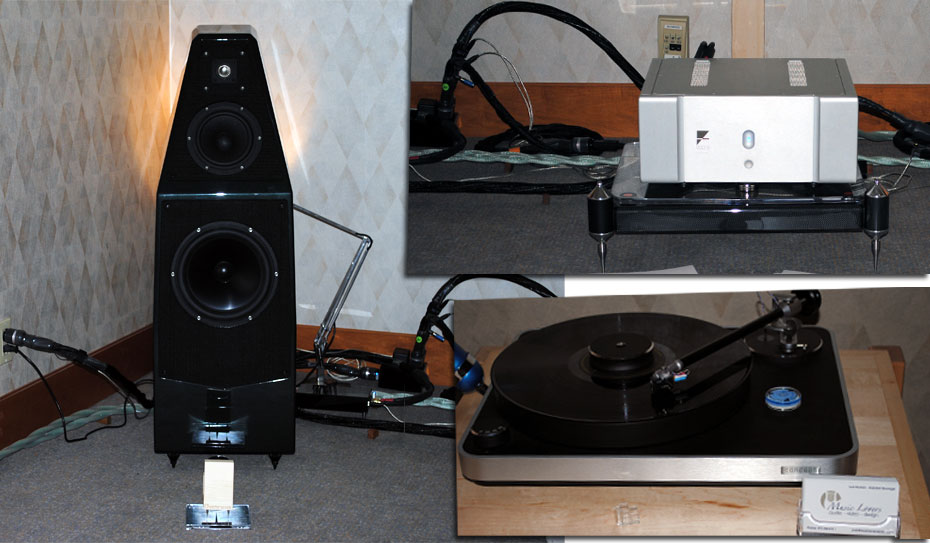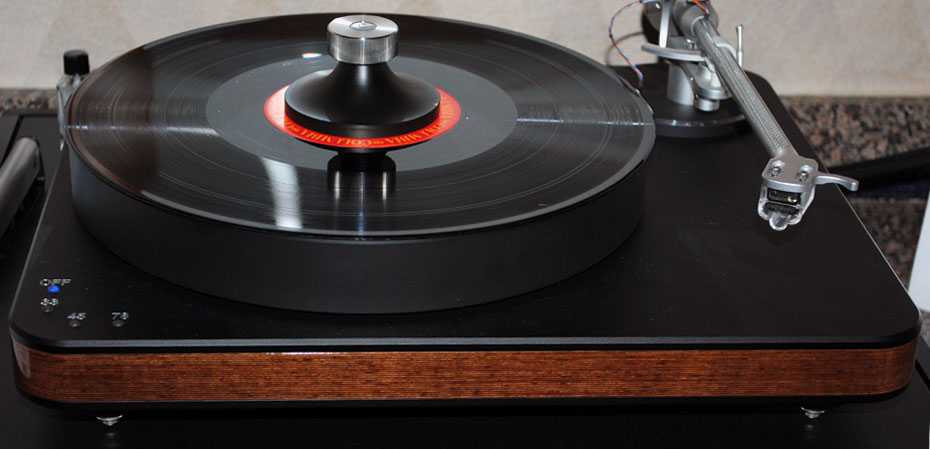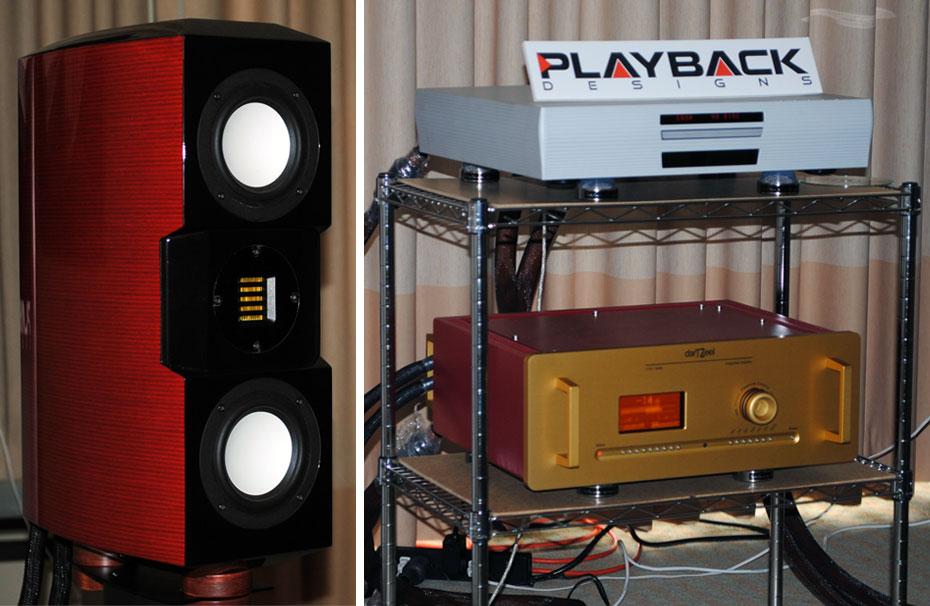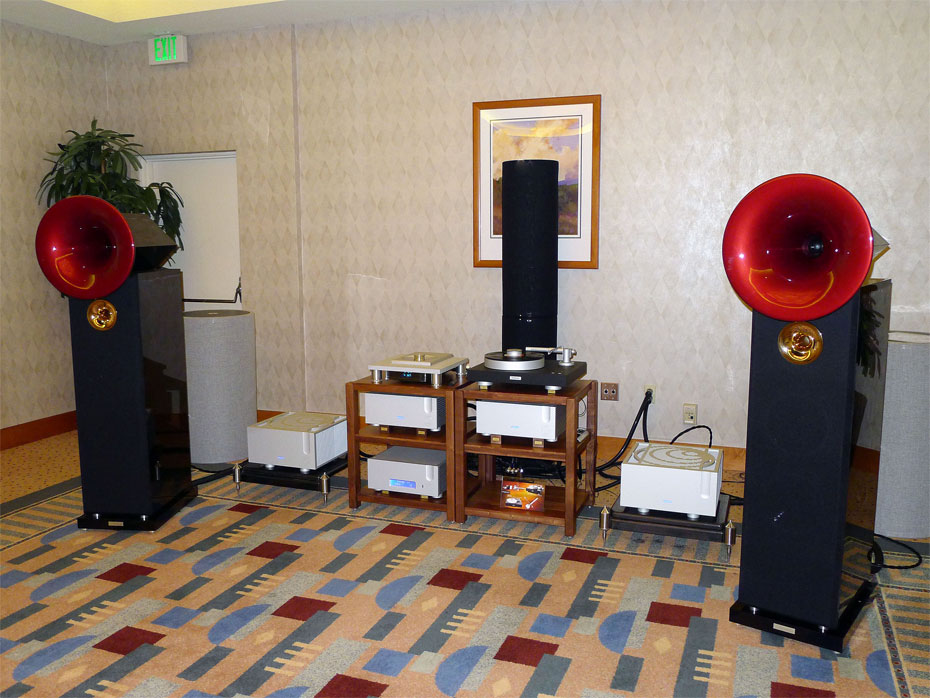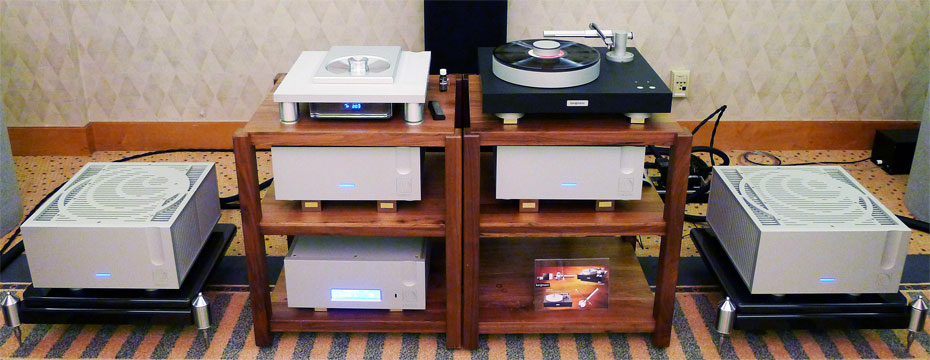Music Lovers/Musical Surroundings (Redwood Room)
System included Ayre DX-5 Universal A/V Engine, K-5xe preamplifier, and V-5xe power amp; Wilson Audio Sophia Series 3 speakers; Clearaudio Ovation Turntable, Concept MC Turntable, Talisman v2 Gold Cartridge; Fosgate Signature Vacuum Tube Phono PreAmp; Tesla Series cables, power cell, Acoustic ART and Galileo Cables; and Grand Prix Audio Core Audio Rack.
This was the smaller of their two exhibits on the first floor of the hotel which were sponsored by Music Lovers and at least to my ears the better. I have always liked the smaller Ayre electronics and this was no exception. It also does not hurt that they were playing vinyl. Very musical with good detail and imaging. There was good air around castanets and other percussion instruments, and good pace. If anything, this system may have smoothed hard sounds a bit.
Favorite Rooms/ Best Sound
I have purposely saved for last what I considered to be the best rooms at the California Show. I would note that many will disagree, but this represents my particular tastes. In no particular order:
Blue Light
Of the many systems which I heard at the show, this is one of the very few that I would consider owning exactly as it was set up. Jonathon Tinn is closely associated with each of these products and assembled a system that was clearly greater than the sum of its parts. Every component represented something very special from a musical perspective.
The Evolution Acoustics MM One Reference Speakers ($2000/ pair), while their least expensive, were ideally suited to the room size and almost full-range. The ceramic midrange/ midbass drivers integrated seamlessly with the ribbon tweeter. The speakers minimized detrimental room interactions. I am not usually fond of ribbon tweeters or ceramic drivers; however, any resonances that might mar the sonics of these drivers were carefully controlled and inaudible. Imaging was excellent, as were dynamics and tonal balance. The amp was the Dartzeel integrated which is beautifully designed and constructed. Digital was provided by the Playback Designs MPS-3 ($8500).
The sound of the combination was stunning. The best way to describe the sound of this system would be to think of the sound of Quad 57’s partnered with tube electronics but with real bass, extension at the top, dynamics and clarity. The sound was sweet and extended but with excellent slam. Male voice was rich, sonorous and harmonically right. Transients and low-level detail were also excellent.
There were two other elements which I should mention as they undoubtedly contributed to the quality of the sound, one was a very inexpensive wire equipment rack which was rather significantly supplemented by Wave Kinetics A10-U8 isolators ($700 set of 4) and 2NS Loudspeakers interface system ($1600 set of 8) and of course cabling by Evolution Acoustics. The combination was stunning.
Loggie Audio
Equipment: Acapella Violoncello speakers; Ypsilon Aelius Hybrid Mono Amps, PST 100 Mk II preamp, and VPS 100 phonostage; Stage III cables, Weizhi power conditioning, Bergman Magne Turntable and integral straight line tonearm with an Lyra Titan i cartridge.
I consider this to be close to the state-of-the-art with respect to what can be accomplished in a home. When a system such as this is “right”, it is extremely difficult to beat without spending outrageous amounts of money. Starting with the speakers, these are probably the “sweet spot” in the Acapella line. These are not the least expensive Acapella speakers which incorporate their plasma tweeter which is bar none the best tweeter that I have ever heard; the next step up will be the model incorporating three woofers. In the past, the Violons (the least expensive with the plasma) have been a difficult load for most amps to drive, low efficiency coupled with very low impedance at some low bass frequencies. The Violoncello’s have solved at least part of this problem with changes to the crossover and the woofers to raise the average impedance at all frequencies to about 8 ohms, making them an easier load for most amps. I heard these at CES driven by a single pair of Einstein OTL’s and the single pair sounded much better than two pairs had in the past. Likewise, I am normally not particularly enamored of hybrid amps; however, the use of Siemens C3g input and an EZ81 rectifier have worked magic in the Ypsilon hybrid monoblock amplifiers. The particular pair at the show have recently been updated by the manufacturer resulting in a significant improvement to the sound which was already excellent originally. At present, this is their best amp unless you need significantly more power. The PST 100 particularly in passive mode is as close to a straight wire with gain as I have heard and as others have said, the VPS 100 phonostage currently defines the pinnacle of the art.
On the Bergmann turntable, I have always been a fan of straight line air bearing tonearms and of air bearings on the platter. Based on my experience using a Lyra Titan in a Rockport, I feel that the linear-tracking arm as executed by the Bergmann is the way to maximize the sound of the cartridge.
What this adds up to is a system that is superbly matched and performs effortlessly. While the system is not perfect it can be stunning particularly on jazz and classical works. One of my top two systems at the CAS.
- (Page 1 of 1)

